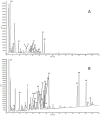Phenolic Compounds and Capsaicinoids in Three Capsicum annuum Varieties: From Analytical Characterization to In Silico Hypotheses on Biological Activity
- PMID: 37836615
- PMCID: PMC10574069
- DOI: 10.3390/molecules28196772
Phenolic Compounds and Capsaicinoids in Three Capsicum annuum Varieties: From Analytical Characterization to In Silico Hypotheses on Biological Activity
Abstract
The affinity of specific phenolic compounds (PCs) and capsaicinoids (CAPs) present in three Capsicum annuum varieties (Friariello, Cayenne and Dzuljunska Sipka) to the transient receptor potential vanilloid member 1 (TRPV1) was investigated by integrating an analytic approach for the simultaneous extraction and analysis through high-performance liquid chromatography coupled with ion trap mass spectrometry (HPLC/ITMS) and UV detection (HPLC-UV) of PCs and CAPs and structural bioinformatics based on the protein modelling and molecular simulations of protein-ligand docking. Overall, a total of 35 compounds were identified in the different samples and CAPs were quantified. The highest content of total polyphenols was recorded in the pungent Dzuljunska Sipka variety (8.91 ± 0.05 gGAE/Kg DW) while the lowest was found in the non-pungent variety Friariello (3.58 ± 0.02 gGAE/Kg DW). Protein modelling generated for the first time a complete model of the homotetrameric human TRPV1, and it was used for docking simulations with the compounds detected via the analytic approach, as well as with other compounds, as an inhibitor reference. The simulations indicate that different capsaicinoids can interact with the receptor, providing details on the molecular interaction, with similar predicted binding energy values. These results offer new insights into the interaction of capsaicinoids with TRPV1 and their possible actions.
Keywords: Capsicum annuum; HPLC-MS; TRPV1–capsaicin interaction; capsaicinoids; docking simulations; phenolic compounds; protein modelling; transient receptor potential vanilloid member 1 (TRPV1).
Conflict of interest statement
The authors declare no conflict of interest.
Figures





Similar articles
-
Evolution of total and individual capsaicinoids in peppers during ripening of the Cayenne pepper plant (Capsicum annuum L.).Food Chem. 2014 Jun 15;153:200-6. doi: 10.1016/j.foodchem.2013.12.068. Epub 2013 Dec 25. Food Chem. 2014. PMID: 24491721
-
Evolution of Capsaicinoids in Peter Pepper (Capsicum annuum var. annuum) During Fruit Ripening.Chem Biodivers. 2016 Aug;13(8):1068-75. doi: 10.1002/cbdv.201500503. Epub 2016 Aug 6. Chem Biodivers. 2016. PMID: 27416068
-
Capsaicinoids in vegetative organs of Capsicum annuum L. in relation to fruiting.J Agric Food Chem. 2002 Feb 27;50(5):1188-91. doi: 10.1021/jf011270j. J Agric Food Chem. 2002. PMID: 11853502
-
Final report on the safety assessment of capsicum annuum extract, capsicum annuum fruit extract, capsicum annuum resin, capsicum annuum fruit powder, capsicum frutescens fruit, capsicum frutescens fruit extract, capsicum frutescens resin, and capsaicin.Int J Toxicol. 2007;26 Suppl 1:3-106. doi: 10.1080/10915810601163939. Int J Toxicol. 2007. PMID: 17365137 Review.
-
Capsicum annuum (hot pepper): An ancient Latin-American crop with outstanding bioactive compounds and nutraceutical potential. A review.Compr Rev Food Sci Food Saf. 2020 Nov;19(6):2972-2993. doi: 10.1111/1541-4337.12634. Epub 2020 Sep 27. Compr Rev Food Sci Food Saf. 2020. PMID: 33337034 Review.
Cited by
-
A Comprehensive Review on Characterization of Pepper Seeds: Unveiling Potential Value and Sustainable Agrifood Applications.Foods. 2025 Jun 1;14(11):1969. doi: 10.3390/foods14111969. Foods. 2025. PMID: 40509497 Free PMC article. Review.
-
Assessment of the Effects of Roasting, Contact Grilling, Microwave Processing, and Steaming on the Functional Characteristics of Bell Pepper (Capsicum annuum L.).Molecules. 2023 Dec 22;29(1):77. doi: 10.3390/molecules29010077. Molecules. 2023. PMID: 38202659 Free PMC article.
-
Structural and Functional Characterization of Lipoxygenases from Diatoms by Bioinformatics and Modelling Studies.Biomolecules. 2024 Feb 25;14(3):276. doi: 10.3390/biom14030276. Biomolecules. 2024. PMID: 38540697 Free PMC article.
-
Aluminium-doped Carbon Dots for the Simultaneous Selective Detection of Five Tetracycline Antibiotics.J Fluoresc. 2025 May;35(5):3071-3081. doi: 10.1007/s10895-024-03738-1. Epub 2024 May 8. J Fluoresc. 2025. PMID: 38717649
References
-
- Qin C., Yu C., Shen Y., Fang X., Chen L., Min J., Cheng J., Zhao S., Xu M., Luo Y., et al. Whole-genome sequencing of cultivated and wild peppers provides insights into Capsicum domestication and specialization. Proc. Natl. Acad. Sci. USA. 2014;111:5135–5140. doi: 10.1073/pnas.1400975111. - DOI - PMC - PubMed
-
- FAOSTAT Crops and Livestock Products. 2021. [(accessed on 28 August 2023)]. Available online: https://www.fao.org/faostat/en/#data/QCL.
-
- Wahyuni Y., Ballester A.R., Sudarmonowati E., Bino R.J., Bovy A.G. Metabolite biodiversity in pepper (Capsicum) fruits of thirty-two diverse accessions: Variation in health-related compounds and implications for breeding. Phytochemistry. 2011;72:1358–1370. doi: 10.1016/j.phytochem.2011.03.016. - DOI - PubMed
MeSH terms
Substances
Grants and funding
LinkOut - more resources
Full Text Sources
Miscellaneous

